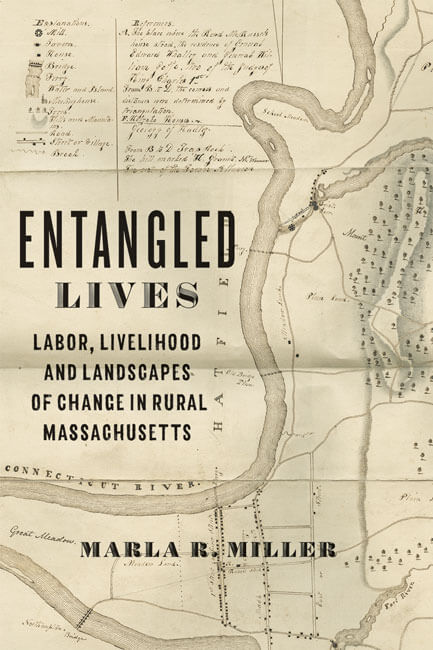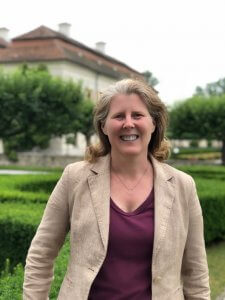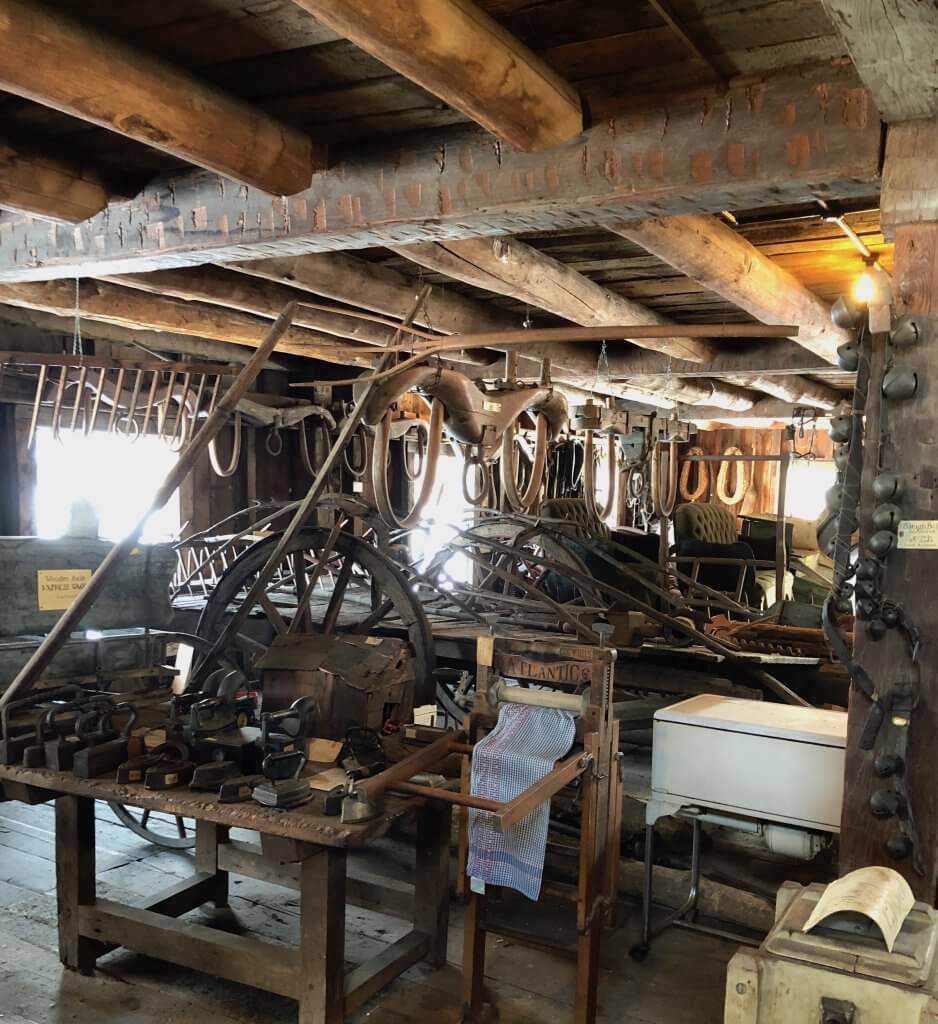Our series of interviews with authors of new books in labor and working-class history continues. This month, Johns Hopkins University Press publishes Marla Miller’s new book, Entangled Lives: Labor, Livelihood, and Landscapes of Change in Rural Massachusetts. Miller, the director of the Public History Program and a professor of history at the University of Massachusetts Amherst, answered questions from Jacob Remes.
Entangled Lives is an intensive look at the work women did in a particular town—Hadley, Massachusetts—in the Early Republican period. What can we learn from studying a particular town this way?
One of the books that was really inspiring to me as I entered the final phases of this project is Making a Living, Making a Difference: Gender and Work in Early Modern European Society (Oxford, 2016), edited by Maria Ågren and reporting on groundbreaking work at Uppsala University. This sweeping study—which tracks men and women’s participation in work both paid and unpaid, formal and informal, through the recovery of verb-based references to labor from a wide range of sources—should be on everyone labor historian’s reading list. In it, Ågren and her collaborators wrote that, in order to understand the braided trajectories that reshaped gendered divisions of labor, the organization of work within and beyond families, and a whole host of intersecting questions, “We need both the big map to find our way in the terrain and the magnifying glass to spot subtleties on the ground” (p. 4). That helped me see exactly what I was trying to do, to apply that magnifying glass to a place I already knew well—Hadley, Massachusetts—to illuminate how that transition looked “on the ground” in this single community in western New England. Tracking those subtleties, as I write in the book’s introduction, “demands a sharp focus and a steady gaze.”

You look at three distinct groups of women—white settler women, free and enslaved Black women, and Indigenous women—and yet your title implies that their work was entangled. How was the work of these women the same, and how was it different from each other?
When I was in graduate school—a long time go now—Elsa Barkley Brown published a watershed article that emphasized how entangled our lives are, in the past and in the present. Brown reminded us that white women and black women’s lives weren’t merely different from one another, but that white women live the lives they do because black women live the lives they do. That was very powerful for me at that time, and remains powerful now, as it is so critically important to understand how our contemporary lives are so deeply entwined with, and dependent upon, those of others, sometimes nearby and sometimes a world away. Entangled Lives works to show that even in the context of post-Revolutionary rural New England, opportunity and constraint operated across the community in ways that were subtle, complex, and mutually interdependent. Looking at taverns both legal and off the books, for instance, or considering how the market for dairy products created very different sorts of roles for women black, white, and native American, in cheese and butter production but also in the making of tools like cheese clothes and baskets—close examination of how women in Hadley participated in these developments helps us calibrate more carefully how larger economic developments affected individuals and households, as well as relationships among them.
The period you’re writing about was a time in which the cash and market economy was growing; one might think of it as the transition period to capitalist modernity. How did this transition play out in the lives of women, and how did women shape the transition?
The five decades that are the focus of this text—the half-century following the American Revolution—saw deep transformations in the nature of the “female economy” of Hadley, as social relations of labor among women were reshaped by the transition toward capitalist modernity. Some areas of activity traced here—women’s work in domestic labor, for instance, as well as in clothmaking and in the hospitality trades—changed markedly; other areas, like nursing (as opposed to midwifery), saw more continuity than change. But in the long term, the knot that entangled together women whose race or economic status otherwise separated them changed form; among other things, it became easier for white middle class women to put some distance (physical, intellectual, social, and cultural) between themselves and women whose circumstances, opportunity, and values differed from their own.

What kind of sources were you able to use to uncover the experiences of your subjects, especially the Black and Indigenous women?
The project was really born when I learned—thirty years ago now—about the voluminous “memorandum book” (as she termed it) of Elizabeth Porter Phelps, a woman of privilege in Hadley, Massachusetts. Phelps’ diary begins in the 1760s when she was a young woman of sixteen, and continues for more than fifty years, until nearly the end of her life (she died in 1817). Each Sunday, she sat down to record the events of the week past, logging the names of dozens of women who crossed her threshold to work for the household, as well as her own travels to their homes, and elsewhere. That record is accompanied by a large correspondence, too—warmer and livelier than the comparatively terse entries of the diary—that paints a fuller picture of women’s labor in Hadley and elsewhere. The Porter Phelps Huntington papers extend over 100 linear feet, and also contain indentures, bills of sale for enslaved laborers, and recollections and reminiscences, and other invaluable documents that help piece together an image of women and work in Hadley.
Most of the analysis is grounded in that key collection, though I’m fortunate in that some ledgers associated with some key figures in early Hadley also survive in the local historical society. And then there are town records, church records—basically I tapped anything and everything I could find that survives from these decades. But key to the analysis is the material record; given that the vast majority of the women I write about it are not represented in any archival collections (and most likely never generated written records to begin with), I look closely at the built environment, cultural landscapes, objects, and even place names to try to extract insight about the work women did, the settings in which it unfolded. I’m keenly interested in the ways that developments in the tangible contexts of women’s work shaped and reflected other changes in community and work culture.
In addition to being a historian of early American women and work, you are also a public historian and public history educator. How does your identity as a public historian shape your research and writing about early American women’s labor history?

Glad you asked! I think had I published this research a decade ago, the resonance between those two aspects of my practice as a historian would not have been as plain to me, but it has become so, particularly after working on another project, Betsy Ross and the Making of America (Holt, 2010), which attempts to replace the iconic “seamstress” of popular historical imagination with the craftswoman (in the upholstery trades, in addition to her well-documented work in flagmaking) known to early Philadelphia.
One of the elements of Entangled Lives that I have come to enjoy most is the book’s “Coda,” which traces how the town of Hadley has understood, forgotten, and remembered this aspect of its labor history. These pages look at pastkeeping among the 19th and 20th-century members of the Porter-Phelps-Huntington family, the c. 1930 the creation of the Hadley Farm Museum (itself a gesture in resistance to the emphasis on elite American decorative arts, and a call to preserve instead agricultural and labor history—I’m hoping to write about that in the future), the mid-twentieth-century founding of the historic house museum at Forty Acres and its more recent evolution as a site interpreting women’s labor (actively engaging the scholarship of Laurel Thatcher Ulrich, Christopher Clark, and others), and other efforts to contemplate how Hadley and communities like it have preserved and interpreted histories of women’s work. I hope that contemplating those trajectories in our collective memory help inform the interpretation of early American women’s work today.
Now that your book is out, what are some books you’re looking forward to catching up on?
Jeremy Zallon’s American Lucifers, which you recently profiled here, is literally right this minute on the top of my to-read stack; I’m always trying to keep up with new work in American material culture, and am eager to dig into this book. And—as I remain at heart a historian of women, craft skill, and fiber arts—I can hardly wait to pick up Hinda Mandell’s edited collection Crafting Dissent: Handicraft as Protest from the American Revolution to the Pussyhats.






